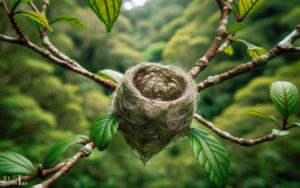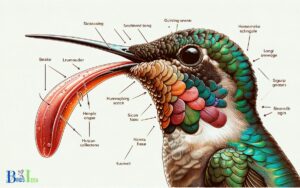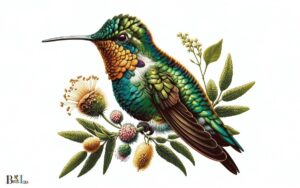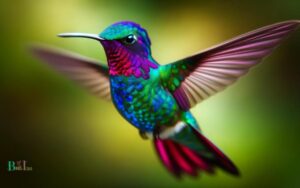What Does a Hummingbird Moth Caterpillar Look Like?
A hummingbird moth caterpillar, also known as a hornworm, has a bright green body with white diagonal lines on its sides. It features a red or orange ‘horn’ at the rear end and can grow up to 2 inches in length.
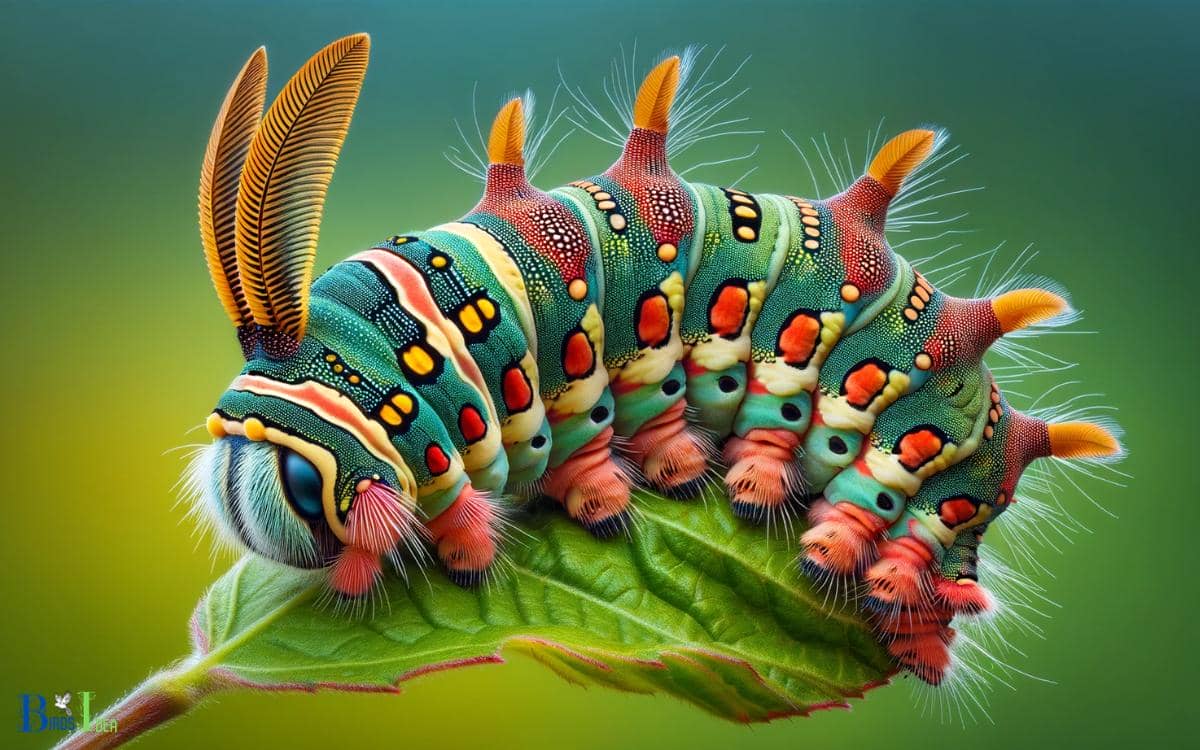
Key Takeaway
Physical Characteristics Of Hummingbird Moth Caterpillars

Hummingbird moth caterpillars are fascinating creatures with unique physical features that distinguish them from other caterpillars. In this section, we will explore their size and shape, coloration, and body structure in detail.
Size And Shape
Hummingbird moth caterpillars are relatively small compared to other caterpillars, measuring around 1 to 2 inches in length.
They have a slender and elongated body shape, almost resembling a miniature snake. Their bodies are segmented, featuring distinct segments that allow flexibility and ease of movement.
Coloration
The coloration of hummingbird moth caterpillars is visually striking and often serves as a protective mechanism against predators.
- These caterpillars are typically green in color, which helps them blend with the surrounding foliage.
- The shade of green can vary, ranging from light green to a more vibrant and intense hue, depending on the species.
Some hummingbird moth caterpillars exhibit markings or patterns on their bodies. These patterns can resemble stripes, spots, or combinations of both, adding another layer of camouflage.
Body Structure
Hummingbird moth caterpillars have a well-developed body structure that aids them in their survival and feeding activities.
- Their bodies are soft and flexible, allowing them to navigate through the intricate flora and foliage where they reside.
- They have three pairs of true legs located on the thoracic segments, which help them cling onto leaves and branches.
- These caterpillars possess additional pairs of fleshy appendages, called prolegs, on their abdominal segments.
Prolegs are equipped with tiny hooks that enable the caterpillar to grasp onto surfaces and move with agility.
Unique Features Of Hummingbird Moth Caterpillars

Hummingbird moth caterpillars are fascinating creatures with a variety of unique features that set them apart from other caterpillar species.
From their distinctive horns or tail-like structures, to their remarkable ability to mimic hummingbirds and their extraordinary camouflage abilities, these caterpillars are truly a wonder of nature.
Horns Or Tail-like Structures
One of the most remarkable features of hummingbird moth caterpillars is their distinctive horns or tail-like structures.
- These structures can be found on both ends of the caterpillar’s body and serve multiple purposes.
- The horn at the front end, also known as a “false head,” helps to deter predators by drawing their attention away from the caterpillar’s vulnerable head.
Meanwhile, the tail-like structure at the rear end aids in gripping surfaces and providing stability while feeding.
Mimicry Of Hummingbirds
Hummingbird moth caterpillars have an incredible ability to mimic hummingbirds, which helps them to survive and thrive in their environments.
- These caterpillars have evolved to resemble these agile birds in both appearance and behavior.
- With their green or brown coloration, slender bodies, and rapid movements, they can easily be mistaken for hummingbirds, even by experienced observers.
This mimicry is not only an impressive adaptation but also serves as a defense mechanism against potential predators.
Camouflage Abilities
Hummingbird moth caterpillars possess outstanding camouflage abilities, allowing them to blend seamlessly with their surroundings.
- Their coloration and patterns closely resemble the leaves and stems of the plants they inhabit, making them virtually invisible to predators.
- This remarkable camouflage helps them remain concealed while feeding or resting, giving them a higher chance of survival.
It’s fascinating to think how these caterpillars have evolved to possess such precise camouflage that helps them blend into their specific habitats.
Life Cycle Of Hummingbird Moth Caterpillars

Understanding the life cycle of hummingbird moth caterpillars can be fascinating and insightful.
These delicate creatures undergo a series of transformations, progressing through various stages before ultimately transforming into the remarkable hummingbird moths we know and admire.
Egg Stage
The life cycle of a hummingbird moth caterpillar begins with the egg stage.
Female hummingbird moths typically lay their eggs on the undersides of leaves, where they remain until they hatch.
The eggs are tiny, oval-shaped, and often pale in color. Within a week or two, these tiny eggs hatch, unleashing the next stage of the caterpillar’s life cycle.
Larval Stage
Once the eggs hatch, the hummingbird moth caterpillars enter the larval stage.
- At this point, they begin their voracious feeding on the leaves of various plants, their main source of sustenance.
- These caterpillars are usually green, blending in with their surroundings, and may sometimes bear markings or spots.
- Their bodies are segmented and adorned with small hairs, adding to their distinctive appearance.
- During the larval stage, hummingbird moth caterpillars go through several molts or instars. With each molting, they shed their old skins, revealing a new, larger one.
This enables their bodies to grow and accommodate their rapid development. As they continue to feed and grow, their characteristic horn-like projections become more pronounced.
Pupal Stage
After accomplishing their ultimate growth in the larval stage, hummingbird moth caterpillars transition to the pupal stage, also known as the chrysalis stage.
- During this transformative phase, the caterpillars seek a sheltered location, often hidden within leaf litter or soil.
- They weave a cocoon-like structure, known as a chrysalis, which serves as their protective shield.
- Within the confines of the chrysalis, a remarkable metamorphosis occurs. The caterpillar’s body transforms, undergoing significant changes to shape and internal structure.
- This process eventually culminates in the emergence of a magnificent hummingbird moth.
- The duration of the pupal stage varies based on several factors such as temperature and environmental conditions.
- Once the metamorphosis is complete, the adult hummingbird moth emerges from the chrysalis, spreading its wings for the first time. It takes a short period for its wings to harden and for the moth to adjust to its newfound abilities.
After emerging, the hummingbird moth is ready to embark on its life as an adult, seeking out nectar and spreading pollen among flowers, ultimately continuing the cycle by reproducing and laying its own eggs.
Habitat Of Hummingbird Moth Caterpillars

The habitat of hummingbird moth caterpillars is an essential aspect of their lives, as it provides the necessary conditions for their growth and development.
By understanding their environment, we can gain insight into their behaviors and preferences.
Geographic Distribution
Hummingbird moth caterpillars can be found in a diverse range of locations around the world.
- They have a wide geographic distribution, inhabiting various continents and countries.
- These caterpillars are known to thrive in North America, Europe, Asia, and Africa.
They have adapted to different climates and ecosystems, showcasing their remarkable resilience.
Preferred Vegetation Types
In terms of vegetation, hummingbird moth caterpillars display a preference for specific plant species.
- These caterpillars tend to seek out plants that serve as hosts for egg-laying. Some common examples include clovers, honeysuckles, and bedstraws.
- These plants offer the necessary nutrients and support for the caterpillar’s growth.
Their choice of vegetation is crucial in ensuring their successful development into adult moths.
Environmental Requirements
Hummingbird moth caterpillars have specific environmental requirements that determine where they can thrive.
- These caterpillars rely on warm temperatures to survive and grow. They prefer habitats with ample sunlight exposure, allowing them to regulate their body temperature effectively.
- Additionally, they require a habitat with abundant nectar sources nearby to sustain their nutrition as they undergo their remarkable transformation.
The presence of predators can significantly impact the survival of hummingbird moth caterpillars.
What Does a Hummingbird Moth Caterpillar House Look Like?
The hummingbird moth caterpillar house is an intricate structure designed with consideration for the needs of these unique creatures. With its hummingbird house design, it features a snug interior to protect the caterpillars from predators and variable weather conditions. The house is crafted with specific entrances and exits to allow easy access for the caterpillars, showcasing a thoughtful design that caters to their needs.
Predators And Defense Mechanisms Of Hummingbird Moth Caterpillars

The world of insects is full of fascinating creatures, and hummingbird moth caterpillars are no exception.
These caterpillars, also known as hornworms, go through a remarkable transformation before turning into beautiful moths.
Natural Enemies
Hummingbird moth caterpillars have several natural enemies in their habitat.
- These include birds, spiders, parasitic wasps, and other insects.
- Birds such as robins and blue jays often feast on caterpillars, while spiders skillfully capture them in their intricate webs.
Parasitic wasps lay their eggs inside caterpillars, eventually leading to their demise. These predators pose a significant threat to the survival of hummingbird moth caterpillars.
Protective Adaptations
To survive in this predator-rich environment, hummingbird moth caterpillars have developed various protective adaptations.
- One of their prominent features is their green coloration, which helps them blend in with leaves and vegetation, making them less visible to predators.
- Some caterpillars even have stripes or spots that mimic the patterns found on leaves, further enhancing their camouflage.
- In addition to their deceptive coloration, these caterpillars also have stiff, horn-like structures called osmeteria that protrude from their thoraxes.
These osmeteria contain glands that can release strong-smelling chemicals. When threatened, the caterpillars extend the osmeteria and emit a pungent odor that repels predators.
Defensive Behaviors
When faced with potential danger, hummingbird moth caterpillars showcase fascinating defensive behaviors.
- They are adept at using their bodies and movement to resemble a snake, which can intimidate would-be predators.
- By arching their bodies and retracting their heads, these caterpillars create the illusion of a threatening serpent, causing predators to think twice before attacking.
- Another defensive adaptation seen in these caterpillars is their ability to release silk threads when disturbed.
- This silk acts as a safety line, allowing the caterpillar to lower itself to the ground quickly and escape from predators lurking above.
- This unique behavior offers a lifeline of escape in situations where flying away is not an option.
Hummingbird moth caterpillars face a wide array of predators during their growth stage. However, through their protective adaptations and defensive behaviors, like their ability to blend in with the surroundings
Conclusion
To sum it up, the appearance of a hummingbird moth caterpillar is quite fascinating. Its distinctive body features include a vibrant color palette, stripes or patterns, and impressive size.
By understanding its appearance, you can easily spot and identify these unique creatures, adding a touch of wonder to your backyard experience.
So next time you spot a caterpillar, take a closer look, it might just be a captivating hummingbird moth caterpillar!

